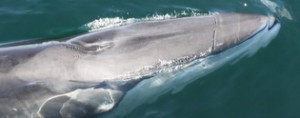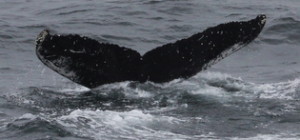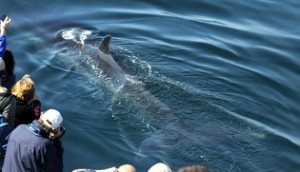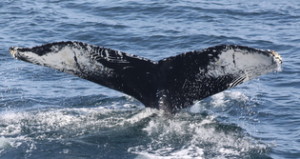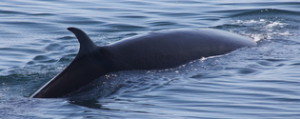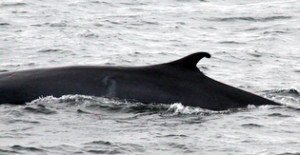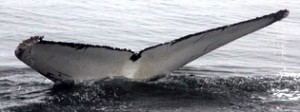September 17 to September 23
The true highlight of September 17th‘s trip was an amazing look at a fin whale mother and calf pair on the mid-day trip. Sightings like this are unexpected in our waters because fin whale sightings in the Gulf of Maine are biased towards males. It is thought that females feed, and also calve, further offshore, probably to the south, and probably in the spring. There are many “probables” here due to sparse data — these fin whales are more elusive than humpbacks and don’t always occur in the large numbers that other whales do. Like other large baleen whales, fin whales have a calving interval of about two years and are likely to stay with their calves for about a year.
When this calf matures, it will grow to be as long as 80 or 90 feet. For now, this little one is dwarfed by its mother, as well as the escorting whale swimming alongside the pair.
Another unusual sighting today was of a small group of Common dolphins. We are used to seeing Atlantic white-sided dolphins in our waters, but today we could tell by the hourglass-shaped pigmentation pattern on the dolphins’ side that another species had made its way to our waters!
September 18 was windy and rough and we had a long trek out to the BD Buoy, one of the markers of the Boston shipping lane. We calculated that we were at least 13 miles to Race Point! Upon arriving, we found ourselves a humpback whale, however, it was rather close to the North Atlantic right whale that has been hanging around offshore, so we had to leave the area. North Atlantic right whales highly endangered and at great risk from ship strikes. Their lack of dorsal fins and habit of feeding just below the surface make them very hard to detect. In an effort to mitigate ship strike risk, there is a law prohibiting the approach of a right whale within 500 yards — that’s about 1/4 mile. We considered ourselves lucky to have seen this whale — one of about 400 on the planet– and then continued our search.
After a great look at a fin whale that sidled up right alongside the Dolphin IX, we had the sighting of a lifetime: a full spinning breach from a basking shark about 100 feet from the boat! We sometimes expect to see our whales leaping out of the water on these rougher days, but we rarely see these huge sharks clear the surface, and it sure made our naturalists’ as well as the passengers’ day!
Individual fin whales seen: Cavity, Martens
Individual humpbacks seen: Ticker
Seas remained rough into September 19th and we headed to the northeast where the waters seemed more productive. There were several humpbacks who appeared to feeding sub-surface. We were able to guess that there was probably a krill patch down there from the bright red defecation that was visible when one of the whales fluked at the surface!
The seas eventually flattened and the feeding continued on, this time by a group of three fin whales who were being pursued by a large flock of Great shearwaters, Cory’s shearwaters, and one Northern Fulmar, probably after the same prey item that the whales were pursuing!
The group of feeding humpbacks finally moved closer to the surface for the afternoon’s trip, and we were able to see them emerge with wide open mouths, and distended ventral pleats. It is not uncommon for fish and plankton to move up and down in the water column at different points during the day in what is called “diel vertical migration.” The movement is likely a predator avoidance strategy for those animals low on the food chain, but frequently they can’t escape the prey-detection abilities of large baleen whales!
Individual fin whales seen: Loon, Braid, Sunspot
Individual humpback whales seen: Banyon, Music, Sundown, Jabiru
Overcast skies and even some rain set the stage for September 20th‘s adventure, but even the long, bumpy ride couldn’t dampen the spirits of the passengers aboard the Dolphin VIII once we had our first sightings–a breaching Minke whale. Minke whales are the smallest baleen whale we would expect to see in the area, and they are normally very low-key, only popping up for short visits to the surface. But when the seas start churning, these little whales often start leaping out of the water.
After getting good looks at that Minke, way to the Northeast we went. And, just when we were beginning to wonder how close we were to the edge of the planet, we went further north and east, making it all the way out to Wildcat Knoll! Rewards for our patience came in the form of a quick look at a Mola mola, as well as a group of seven humpback whales, including Music, Jabiru, Banyon, and Sundown. These whales were likely feeding down deep, but while we were waiting for them to resurface, a fin whale appeared, giving us great looks at the second largest animal ever to have existed!
Birders on board the Dolphin X also got a payoff for their patience by getting a chance to see a Sabine’s gull, one of the rarest gulls that we see here in the Gulf of Maine. The Sabine’s gull is the only member of its genus, and unlike most of the other gulls seen from our boats, this is considered a true pelagic species, meaning that it spends of its life at sea, breeding in the Arctic. When we see them come through New England in the fall, we are catching them on their migratory route.
Individual humpback whales seen: Music, Jabiru, Banyon
Even though it’s a far trek, we decided to head back to Wildcat Knoll on September 21st having had such great luck the previous day. On the way out, we got amazing looks at several blue sharks! One of these sleek and shiny sharks came right towards the boat, and we noticed a hunk of reddish flesh in the water near it? Perhaps remnants of a tuna lunch?
As we got further out, we were excited to find something a little bit different — a group of 3 sei whales! These streamlined whales are often mistaken for their larger cousins, the fin whales, but their taller dorsal fins and tendencies to travel in groups revealed their true identity. Like the North Atlantic right whale, these baleen whales also feed on calanoid copepods. Having seen right whales in the area earlier this week, the presence of sei whales was not a complete surprise.
The humpbacks from yesterday’s trip were still feeding away, lunging to the side through their prey. Though we couldn’t tell what they were feeding on by what was going into their mouth, we could take a pretty good guess that it was krill from the color of what came out the other end. For many on the boat, the surprising bright oranges and reds, surely from krill and copepods, were a trip highlight!
Music, Banyon, Sundown, Indiana and Jabiru were among the humpbacks seen today. Look for the very distinct musical staff and note on this whale’s lower right fluke!
Individual humpback whales seen: Banyon, Sundown, Indiana, Music, Jabiru
Despite the foggy conditions on September 22nd, we had exciting whale watches throughout the day. On our mid-day trip, we encountered a huge pod of Atlantic white-sided dolphins. Our naturalists estimated that there were between 300 and 500 of these dolphins, many of whom had calves. The calves were shaped like little footballs and traveled right along side their mothers save for an occasional leap from the water.
We also had another brief sighting of a sei whale, followed by a look at Loon, a fin whale. Fin whales and sei whales are often mistaken for one another. Fin whales are longer, but sei whales tend to have taller, falcate, or more sickle-shaped dorsal fins. In the photos below, see if you can tell the difference:
Individual fin whales seen: Loon
Fogginess continued into September 23rd, but we headed back up to the northeast where we found four humpbacks, including Etch-A-Sketch, Mayo, and Lutris. We must have been sitting on top of a huge patch of krill because these whales were feeding upside down and sideways lunging right next to the Dolphin X!
Mayo, pictured above, was born in 2004 to Apostrophe, who has had six calves in total. Lutris is also a relatively young whale. Lutris was born in 2002 to Lava, but was only seen in this area in the past year.
Even though we’ve crossed the Autumnal Equinox, we still have about a month of whale watching to go. The fall is a lovely time to visit Provincetown and see the exciting changes that happen out on Stellwagen Bank!
Individual humpback whales seen: Etch-A-Sketch, Mayo, Lutris






